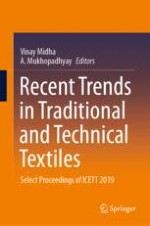2021 | OriginalPaper | Buchkapitel
Investigation of Flammability Parameters of Different Types of Fabrics Using Digital Image Processing Technique
verfasst von : Ajit Kumar Pattanayak
Erschienen in: Recent Trends in Traditional and Technical Textiles
Verlag: Springer Singapore
Aktivieren Sie unsere intelligente Suche, um passende Fachinhalte oder Patente zu finden.
Wählen Sie Textabschnitte aus um mit Künstlicher Intelligenz passenden Patente zu finden. powered by
Markieren Sie Textabschnitte, um KI-gestützt weitere passende Inhalte zu finden. powered by
